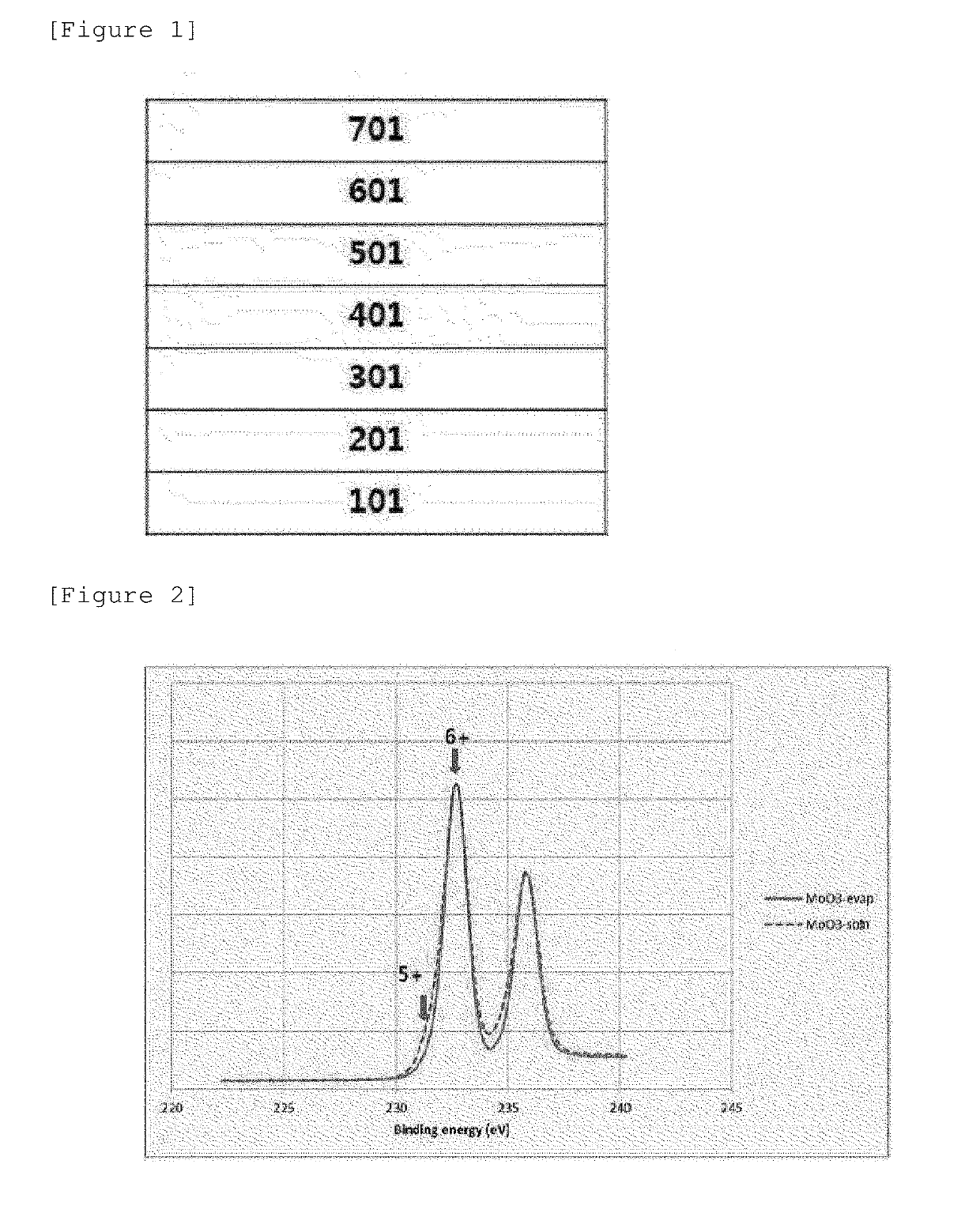Organic Electroluminescent Device And Manufacturing Method Therefor
a technology of electroluminescent devices and manufacturing methods, applied in the direction of semiconductor devices, basic electric elements, electrical apparatus, etc., can solve the problems of high equipment investment and process costs, low material utilization rate, and high probability, and achieve the effects of enhancing characteristics, reducing the deterioration of charge characteristics by residual organic materials, and improving interface characteristics with electrodes
- Summary
- Abstract
- Description
- Claims
- Application Information
AI Technical Summary
Benefits of technology
Problems solved by technology
Method used
Image
Examples
example 1
[0121]A solution in which copper acetate and Mo(CO)6 at a weight ratio of 0.8:99.2 were dissolved at a concentration of 4 wt % in cyclohexanone was prepared. A glass substrate coated with ITO was washed sequentially with water and isopropanol, and then the mixed solution was spin-coated onto an ITO-deposited base material at 1,000 rpm for 30 seconds. The obtained thin film was subjected to heat treatment under an oxygen atmosphere at 200° C. for 15 minutes, thereby forming a hole injection layer having a very uniform thickness of 30 nm.
[0122]A hole transporting layer having a thickness of 45 nm was formed on the top of the hole injection layer by using 4,4′-bis[N-(1-naphthyl)-N-phenylamino]biphenyl (NPB).
[0123]An electron blocking layer was formed to have a thickness of 15 nm on the top of the hole transporting layer. BH of the following chemical formula being a blue fluorescent host was doped with BD being a blue dopant at a weight ratio of 95:5 on the electron blocking layer, ther...
example 2
[0126]A device was manufactured in the same manner as in Example 1, except that NaNO3 and MoO2(acac)2 at a weight ratio of 5:95 were dissolved at a concentration of 4 wt % in ethylene glycol monomethyl ether, the resulting solution was coated at 1,000 rpm on an ITO-deposited base material, and then a heat treatment was carried out under an oxygen atmosphere, thereby preparing a hole injection layer. At this time, the thickness of the hole injection layer was 30 nm. Characteristics of the device are shown in Table 1.
example 3
[0127]A device was manufactured in the same manner as in Example 1, except that AgNO3 and MoO2(acac)2 at a weight ratio of 0.5:99.5 were dissolved at a concentration of 4 wt % in ethylene glycol monomethyl ether, the resulting solution was coated at 1,000 rpm on an ITO-deposited base material, and then a heat treatment was carried out under an oxygen atmosphere, thereby preparing a hole injection layer. At this time, the thickness of the hole injection layer was 30 nm. Characteristics of the device are shown in Table 1.
PUM
 Login to View More
Login to View More Abstract
Description
Claims
Application Information
 Login to View More
Login to View More - R&D
- Intellectual Property
- Life Sciences
- Materials
- Tech Scout
- Unparalleled Data Quality
- Higher Quality Content
- 60% Fewer Hallucinations
Browse by: Latest US Patents, China's latest patents, Technical Efficacy Thesaurus, Application Domain, Technology Topic, Popular Technical Reports.
© 2025 PatSnap. All rights reserved.Legal|Privacy policy|Modern Slavery Act Transparency Statement|Sitemap|About US| Contact US: help@patsnap.com



